 This article on Dalmatians is part of a series to highlight the Big Picture of health, welfare and breeding and to help develop Globally Relevant Integrated Health Profiles (GRIHPs) for many breeds. See IPFD's Get a GRIHP! on Breed Health Initiative.
This article on Dalmatians is part of a series to highlight the Big Picture of health, welfare and breeding and to help develop Globally Relevant Integrated Health Profiles (GRIHPs) for many breeds. See IPFD's Get a GRIHP! on Breed Health Initiative.
There are many others doing great work to advance health, well-being, and welfare in this wonderful breed. We reference and link to terrific work, developments, reports, and research from the UK, USA, Sweden, Finland, and more below. Thanks to all of those working on behalf of Dalmatians.
This is a 'living document' - so if anyone has more material to share or point us to - please let us know!
Table of Contents
Breed at a glance
-
Dalmatians are an overall healthy breed. Many individual dogs reach 10+ up to 15 or 16 years of age. The dogs are energetic, athletic and intelligent. These playful, friendly, sensitive, loyal companion dogs historically served as watch dogs, perhaps as hunting dogs and were known to accompany carriages and fire wagons. This is not a breed that will do well living in confined spaces. There has long been concern that seeing these distinctive dogs on the big-screen in Disney's films, 101 Dalmatians and more recently in Cruella, prompts many people to rush into buying one, without considering whether they actually have the means necessary to keep one long-term.
Key Health Conditions
-
Dalmatians have an issue with high uric acid, as the SLC2A9 mutation is fixed in the breed.
-
A homozygous state of the SLC2A9 mutation can lead to problems caused by increased urinary uric acid, which includes the formation of urate crystals, urinary bladder aggregate formation, urate stones, conditions that ultimately may lead to urinary tract obstruction and even death (See: https://www.luadalmatians-world.com/enus/ and http://www.luadalmatians.com.)
-
Note: A crossbreeding with a Pointer was done in the 1970s, with the objective of introducing the normal gene variant into the breed. Dalmatians which have received the normal variant are called LUA (Low Uric Acid) or nowadays preferentially NUA (Normal Uric Acid) dalmatians. For a history and further information see Luadalmatians.com.
-
Breed-specific breeding programs recognise skin issues: allergies, atopies, furunculosis, fungal and ear infections as problems in the breed.
-
bronzing skin syndrome (“Dal crud”): affected dogs have a patchy hair coat and their skin has a bronze hue. There is inflammation of the hair follicles. This appears to be related to the excessive uric acid excretion that occurs in the Dalmatian, and the associated tendency to develop urinary stones (urate urolithiasis).
-
Dalmatians may have deafness associated with their white colour. Hearing is routinely tested with BAER (Brainstem Auditory Evoked Response) method before the age of 7 weeks.
-
Hip dysplasia is one of the frequently recommended or required screenings for the breed, but Dalmatians are not prone to severe hip dysplasia.
-
Inherited human ARDS (adult/acute respiratory distress syndrome) - type syndrome is found from the breed in the Finnish population. The Finnish breed club has published an inheritance map: https://www.findal.net/@Bin/175825/ardstree.gif
-
The breed is also prone to idiopathic epilepsy.
-
Several studies have been done on dwarfism / chondrodysplastic growth: https://www.wafdal.org/index.php/de/health “Zwergenwuchs”, “Dwerggroei”, “Nanisme”

What do caretakers need to know
Dalmatians are loyal, active dogs. Healthy adult dogs require regular exercise. Really...these dogs can be boisterous with seemingly unending energy. Training and socialization of puppies is important. Yes! It's true these dogs are adorable in Disney's movies, 101 Dalmatians and in Cruella; but please make sure your lifestyle will accommodate the dog's needs - before you get a puppy.
 Deafness has long been known to occur in this breed. It has generally been accepted by breeders that there is a relationship between skin/coat colour / spotting and pigmentation of eyes and lips/nose and deafness - researchers continue to study the relationship. See the Genomics of deafness in the dalmatian from the 4th IPFD International Dog Health Workshop.
Deafness has long been known to occur in this breed. It has generally been accepted by breeders that there is a relationship between skin/coat colour / spotting and pigmentation of eyes and lips/nose and deafness - researchers continue to study the relationship. See the Genomics of deafness in the dalmatian from the 4th IPFD International Dog Health Workshop.
Urinary tract and bladder stones are known to occur in this breed. A DNA test is available. Dietary management can help dogs that have a tendency to form urate stones. See the British Dalmatian Club's Dalmatia Uric acid Flyer: http://www.britishdalmatianclub.org.uk/downloads/dalmatian-uric-acid-flyer.pdf for an overview. Left untreated stones can be deadly.
These dogs do not do well as kennel/outside dogs or if left for long hours on a daily basis.
Their short coats do not offer protection in very cold weather; a good vacuum is advised as the dogs shed - all the time.
Statistics and Health Strategies
Population Statistics

AKC ranked dalmatians at #51 in 2020 and at #49 in 2021. Based upon the numbers of AKC registrations known for other breeds the 51st and 49th ranking for dalmatians likely represents somewhere between 1600- 2000 dalmatian dogs registered.
Health and Longevity Statistics
 Agria - Swedish Breed Profiles
Agria - Swedish Breed Profiles
CONTEXT: For many years, Agria Animal Insurance, Sweden (Agria Djurförsäkring, Stockholm, Sweden) has supported veterinary research and provided statistics on diagnoses for health and life claims to Swedish breed clubs. See Breeds with Swedish Insurance Data and Agria Breed Profiles (where breeds are compared to All Breeds)! We recommend that you download the Agria Breed Profiles for the Dalmatian and study them for full available information. Some excerpts are shown below! The great benefits of the Swedish insurance data are that they include almost 40% of the national population of dogs, so are very representative; note that animals at very old ages are likely under-represented. Most importantly, information is available on all insured dogs, not simply those who get sick or die. This allows calculation of population-based rates (expressed as events per 10,000 years-at-risk) as well as risks and proportions. Statistics are presented as overall morbidity (rate of one or more veterinary care events [VCE]) or mortality (death), by general diagnostic categories, and by specific diagnoses.
Extracts from Veterinary Care Events - MORBIDITY
Relative Risk Morbidity of Dalmatians compared to All Breeds: 1.12. (The risk in the Dalmatian is 1.12 times as high than for All Breeds.


Most frequent general causes: injury, locomotor, digestive and skin.

Largest relative risks compared to All Breeds:
-
urolithiasis (bladder/urinary tract stones) : from 5 to >8 times the risk in All Breeds,
-
shoulder, hock, and vertebral problems: 3-4 times the risk in All Breeds, and
-
incontinence: ~ 2.6 times the risk in All Breeds.

Extracts from Agria Breed Profile (Life) - MORTALITY
Median Age (years) at death: 7.3 (All Breeds: 7.4).

Mortality - Relative Risk Mortality of Dalmatian compared to All Breeds: 0.88. (The risk in the Dalmatian is 0.88 times as high, i.e., lower, than for All Breeds.)

Most frequent general causes of death: locomotor, heart, neoplasia, digestive.

Dalmatians have larger relative risk compared to All Breeds only for two conditions: immunological and heart. Highest increased risk is 2.4-3.
Finland: Mortality Data 2012-2021
Longevity and causes of death in Finland - 2012-2021, Finnish Kennel Club breeding database:
-
Average lifespan 10 years 4 months
-
Average lifespan 13 years 2 months when the cause of death is old age
-
Most common specified causes of death: old age, tumor & cancer, spinal, digestive and skeletal disease

Breed-specific Breeding Strategies
-
The Kennel Club, UK: Breed Watch (Category 1)
-
Sweden: Breed-specific Breeding Strategies: (in Swedish) and/ or English summary
-
Finland: JTO: https://jalostus.kennelliitto.fi/RotuPDF.ashx?R=153&T=2
-
Norway: RAS: https://www.nkk.no/getfile.php/131570-1528360288/Filer/RAS/RAS/Dalmatiner RAS v1.pdf
-
US: CHIC: http://www.caninehealthinfo.org/brdreqs.html?breed=DM
HGTD DNA Tests for Dalmatians
The Harmonization of Genetic Testing for Dogs (HGTD) Basics: The HGTD Searchable Database - Search by Breed, Search by Disease / Test and Search by Genetic Test Provider (GTP) / Lab + Genetic Counselling Resources. HGTD catalogs information provided voluntarily from genetic test providers (GTPs) including information on their company and services, quality measures and expertise, tests offered and more. As of January 2021, the HGTD Database includes 82 academic and commercial genetic test providers (GTPs) in 22 countries. Our searchable genetic phenes (phenes = characteristics/genetically controlled feature) database currently holds information on 300+ phenes across all breeds/types and provides information on each phene: links to the Online Mendelian Inheritance in Animals database (OMIA), gene + mutations, a simple and advanced disease description, inheritance details, links to original publications, patents/licenses, comments from the original researchers/experts on application, and breed specific information (such as research/validation) - where possible. Breed Relevance Ratings (BRR) support evidence-based usage and application of genetic tests. The HGTD database relevance rating indicates the level of available evidence supporting the application of a specific genetic test for a specific breed/type. Currently, the relevance rating is based on a wide variety of evidence sources. This includes peer-reviewed research papers, recommendations from the original researchers/test developers, input from additional experts including veterinary specialists, and breed experts. It is hoped that, by being more informative about what we currently know or do not know about a specific test for a specific breed, that dog health advisors and owners can make more informed decisions. Remember, this Breed Relevance Rating is not everything we need to know about the disease or characteristic; it is focused on the genetic test.
HGTD - DNA tests for Dalmatians
Summary: The available genetic tests for Dalmatian are generally for very rare or almost unobserved diseases/conditions. While pre-breeding genetic testing are valuable, a breeder may wish to be particularly thoughtful of genetic diversity, behaviour/temperament, and other factors when selecting mates.
♦ BIG PICTURE THINKING ♦Please take into consideration - Most of the conditions with genetic tests are rare in the general population, but valuable for breeders to use to efficiently reduce risks while supporting good genetic diversity in the breed as a whole. See the Genetic Diversity section below. Also be aware that there are many DNA tests that are available for ALL breeds, that while the test itself is valid, the condition may not be a major health concern or included in health strategies for every breed. See the HGTD for a full list of DNA tests including "Trait" and "Parentage" tests.
Dalmatian:
Test: Familial Fatal Acute Respiratory Distress Syndrome (ARDS)
BRR: 
HSP comment:
ARDS is a syndrome of the respiratory system that is often fatal. Researchers into ARDS estimated a low carrier frequ ency rate for the mutation (under 2%), meaning this condition may be rare or uncommon in the breed. This also means that effective elimination of the ARDS in the breed could happen with sensible breeding practices to avoid producing puppies with this genetic variation. In the research study, Pointers were also tested for the mutation, but in the samples available, it was not detected. However, ARDS is described in many species and across many types of dogs, so it is possible that other breeds have unique as yet unknown genetic risks. Tests for this specific variant should be assumed to be informative for Dalmatians (and Dalmatian crosses) only, for the time being.
ency rate for the mutation (under 2%), meaning this condition may be rare or uncommon in the breed. This also means that effective elimination of the ARDS in the breed could happen with sensible breeding practices to avoid producing puppies with this genetic variation. In the research study, Pointers were also tested for the mutation, but in the samples available, it was not detected. However, ARDS is described in many species and across many types of dogs, so it is possible that other breeds have unique as yet unknown genetic risks. Tests for this specific variant should be assumed to be informative for Dalmatians (and Dalmatian crosses) only, for the time being.
Test: Hyperuricosuria and Hyperuricemia (HUU)
BRR: 
HSP comment:
Hyperuricosuria (HUU) describes elevated levels of uric acid in the urine causing the formation of calculi (stones) in the urinary tract and they can occur in many types of dogs. Most populations of dalmatians are fixed for this variant, meaning that they all carry the genetic risk for bladder or kidney stones. Owners and breeders are often able to manage this condition well with appropriate diet and care. There have been careful outcross programs with Pointers in the past, to remove the genetic risk variant for HUU while retaining the dalmatian breed characteristics. This resulted in some dalmatians who do not have this genetic risk variant.
Other Genetic Tests offered as breed-specific:
Degenerative Myelopathy, please find important information here (Infographic quick facts on degenerative myelopathy and genetic-testing) and here (Blog: Correcting the confusion around degenerative myelopathy) on DM.
Other Genetic Traits:
Coat colour, dilution, MLPH-related; long hair
In addition, there are many genetic tests available for all dogs (not breed-specific) which may be important to individual dogs or for breeding information.
Health Screening Tests for Dalmatians
UK
The Kennel Club UK's Dalmation page lists Hearing testing (BAER programme) of puppies as a priority test. Hip Dysplasia and the DNA test – HUU are mentioned as important considerations for breeding dogs.
Research conducted by Tom Lewis, Julia Freeman, Luisa De Risio first published in 16 June 2020 shows a Decline in prevalence of congenital sensorineural deafness in Dalmatian dogs in the United Kingdom . Also see The Kennel Club's article: New study reveals deafness in Dalmatians declines thanks to careful breeding decisions
Finland
Breeding Strategy for Dalmatians in Finland: https://jalostus.kennelliitto.fi/RotuPDF.ashx?R=153&T=2
Notes:
-
Skin problems are the most common health issue
-
Screenings of the spine are partly financed by the Finnish Breed club. Lately almost 30 % of registered dogs have been screened.
-
BAER-tests are also partly financed by the breed club for their member breeders.
-
Mandatory hip dysplasia screening for parents of litters, limit C. Since 2002 there has been only one dog with E hips
Hip and elbow screenings are done for approximately 40 % of dogs.
Over 80 % of dogs have normal (A) or borderline (B) hip joints.

Approximately 95 % of dogs have normal or borderline (0) elbow joints.

During the past four years, 93-100 % of dogs have been free of spondylosis.

Lumbosacral transitional vertebrae by statement year:

BAER results (source: Dalmatians breed-specific breeding strategy):

>Pentuja = puppies; + = hearing; ? = status not known; - = deaf; yht = total
Sweden
RAS in Sweden: https://www.skk.se/globalassets/dokument/rasdokument/ras-dalmatiner.pdf
Notes:
-
No mandatory screenings for registration
-
20 % of registered Dalmatians were screened for hip dysplasia (2013-2017)
-
16 % of dogs had mild dysplasia (C) or worse. The breed club doesn’t recommend breeding with C hips and doesn’t allow breeding with D (moderate dysplasia) or worse hips.

Almost all screened dogs were free of elbow dysplasia.

Hearing results 2012-2017

Tabell 3. Inrapporterade BAER resultat redovisade som % för åren 2010-2017=
Chart 3. Reported BAER resultspresented as percentages for years 2010-2017
bi (%) = percentage of bilateral hearing
uni (%) = percentage of unilateral hearing
Döva (%) = percentage of deaf puppies
Antal testade= number of tested

Tabell 4. Antal inrapporterad döva valpar från valpkullsrapporterna för åren 2012-2017=
Chart 4. Number of reported deaf puppies from litter reports for for years 2010-2017
Döva uppfödarmetoden=deaf by breeders method
Döva BAER=Deaf by BAER
Total Döva=Total number of deaf
Antal kullar=number of litters
Registrerade valpar=registrated puppies
· Issues very similar and at a similar scale as in Finland.
Norway
Breeding Strategy (RAS) in Norway: https://www.nkk.no/getfile.php/131570-1528360288/Filer/RAS/RAS/Dalmatiner RAS v1.pdf
Notes:
-
Only hip dysplasia results A and B are approved in breeding.

-
Osteochondrosis diagnosed dogs are not allowed in breeding by breed club.
-
Norway lists also two chondrodysplastic (dvergvekst) dalmatians from years 2003 and 2009.
-
Faulty coloured dogs (patch, yellow or orange spots, missing pigment in nose or eyelids) are not allowed in breeding and go to limited register.

Picture 2. Proportion of puppies born with patch, blue eyes and deaf (Norwegian RAS, page 5).
-
Other issues are mainly the same as in Finland and Sweden, only Wobbler syndrome is added on list in Norway. The Breed club has has 6 verified cases in last 20 years.
France
French Breed Club, Dalmatien Club Français: https://www.dalmatien-club-francais.org/">

Notes:
For 2 points and onward, the BAER-test must be done.
For 4 points and onward, a hip dysplasia result of A or B is required. Together with other demands this gives the dog a title “recommended”.
“Confirme” means that dog has been evaluated by an approved judge.
Health concerns in French Dalmatians:
US
 OFA, working with the breed's parent club, recommends the following basic health screening tests for all breeding stock. See: https://www.ofa.org/recommended-tests?breed=DM
OFA, working with the breed's parent club, recommends the following basic health screening tests for all breeding stock. See: https://www.ofa.org/recommended-tests?breed=DM
Hip Dysplasia (One of the following)
OFA Evaluation
PennHIP Evaluation
Congenital Deafness (One of the following)
OFA evaluation based on BAER test
GDC evaluation based on BAER test
Health Elective (One of the following)
OFA Thyroid evaluation from an approved laboratory
ACVO Eye Exam - Results registered with OFA
Health test results are located in OFA's Breed Summary Report
Netherlands
Dutch Breed Club, De Nederlandse Club voor Dalmatische Honden: https://www.ncdh.nl/
Breeding rules of the Breed Club (vereiningsfokreglement van de Nederlandse Club voor Dalmatische Honden): https://www.ncdh.nl/images/downloads/fokreglement.pdf
Part 4 gives health regulations:
-
All screenings according Dutch kennelclub (Raad van Beheer) protocols
-
Hip dysplasia screening mandatory, limit C, which is allowed to be combined only with A
-
Hearing test, only both side hearing allowed in breeding
-
Only correct colour allowed, so no yellow or orange spotting etc.
Germany
Germany has four registering breed associations under VDH.
KEY
R1-Mandatory for registration
R2-Recommended
R3-Recognised
|
Registration, health
notes and requirements
|
Club für Dalmatiner-
Freunde e.V.
|
Dalmatiner Verein
Deutschland e.V.
|
Dalmatiner Zucht Gemeinschaft Deutschland e.V.
|
Deutscher Dalmatiner-Club von 1920 e.V.
|
|
Urinary Stones
|
R3
|
|
R3, explained
|
|
|
Colour, Skin & Allergy
|
R3, added demodicosis and bronzing syndrome
|
Faulty colours not allowed in breeding
|
Disqualifying faults close from breeding
|
Link to colour testing labs
|
|
Hip Dysplasia
|
R1, HD A and B, C can be mated only to A
|
R1, HD A and B, C can be mated only to A
|
R1, HD A and B, C can be mated only to A
|
R1, HD A, B, C
|
|
Elbow Dysplasia
|
|
|
R2, free willing
|
|
|
BAER Test
|
R1, +/+
earliest 7 weeks
|
R1, +/+ for breeding approval
|
R1, +/+ hearing
|
R1, +/+
|
|
Source:
|
Zuchtordnung: https://www.cdf-dalmatinerverein.de/dokumente/Zuchtordnung_Stand_2020.pdf
|
Zuchtordnung: http://www.dalmatineronline.de/downloads/Satzung2017_14022017.pdf
|
Zuchtordnung: https://www.dalmatiner-deutschland.de/images/downloads/ordnungen/neu/zuchtordnung_stand_2018.pdf
|
Zuchtordnung:
https://www.dalmatiner-ddc.de/dokumente/Zuchtordnung_2015.07.pdf
|
Dalmatians - Health Screening Summary - by country
R1-Mandatory for registration
R2-Recommended
R3-Recognised
|
Condition
|
US
|
UK
|
Finland
|
Sweden
|
Norway
|
Netherlands
|
France
|
Germany
|
|
Hip Dysplasia
|
R2
|
R2
|
R1
|
R2
|
R1
|
R1
|
R2
|
R1
|
|
Elbow Dysplasia
|
|
|
R2
|
R3
|
R3
|
|
|
R2
|
|
Deafness
|
R2
|
R2
|
R2
|
R2
|
R2
|
R1
|
R2
|
R1
|
|
Epilepsy
|
|
|
R2
|
|
|
|
|
|
|
Color
|
|
|
R2
|
|
R1
|
R2
|
R2
|
R1
|
|
Skin Issues
|
|
|
R2
|
R2
|
R2
|
|
R2
|
R2
|
|
Uric Acid
|
|
R2
|
R3
|
R2
|
R2
|
|
R2
|
R3
|
|
Osteochondrosis
|
|
|
R2
|
|
R2
|
|
|
|
|
Chondrodysplasia
|
|
|
|
|
R2
|
R2
|
R2
|
R2
|
|
Heart
|
|
|
R2
|
R2
|
|
|
|
|
|
Adult/acute respiratory distress syndrome
|
|
R2
|
R3
|
|
R2
|
|
R2
|
|
|
Thyroid
|
R3
|
|
|
|
|
|
|
|
|
Eye Exam
|
R3
|
|
|
|
|
|
|
|
|
Megaesophagus
|
R3
|
|
R3
|
R3
|
R2
|
|
R2
|
|
Genetic Diversity - Dalmatians
"There are several resources available to both individual breeders and breed organizations (clubs and kennel clubs) that can help to monitor and track genetic diversity, and estimate an individual dog's diversity relevant to a breed population. Each have advantages and disadvantages but can play a role in improving genetic diversity, including:
-
Pedigree-based COI estimations (Coefficient of Inbreeding)
-
Genomic COI calculations
Often associated with COI:
-
Popular sire tracking. Access to breed-wide data will vary by country, breed/kennel club. Some clubs restrict numbers of litters born to sires/dams to reduce the impact of popular sires.
-
Breed diversity reports/research. Some kennel clubs, breed clubs, researchers and commercial genetic test providers have undertaken breed reports on population differences, including genetic diversity and inbreeding, popular sires/dams, etc. "
Comment... As a rule when sorting through the questions about genetic diversity, genomic COIs are usually much higher than pedigree-based. Advice - seek out dogs with a lower than breed average in both pedigree and genomic COI. Also, when looking at pedigree-based COIs, it is important to know how many ancestral generations have been used in the calculation. Advice is to keep 4-5-generation COIs at 6,25 % or lower. If that's not possible, then lower than breed average.
Dalmatians - Genetic Diversity Research
This research covers the German dalmatian population... Vasiliadis, D., Metzger, J. & Distl, O. Demographic assessment of the Dalmatian dog – effective population size, linkage disequilibrium and inbreeding coefficients. Canine Genet Epidemiol 7, 3 (2020). https://doi.org/10.1186/s40575-020-00082-y
Embark for Breeders recently posted the following graphic on their Facebook page with the following explanation, "We consulted our database to "spot" the average genetic COI of the Dalmatian, coming in at 19%." We do not know how many Dalmatians are included in Embark's COI documentation.

UK - The Kennel Club - Population analysis for Dalmatitians (2015)... Lewis, T.W., Abhayaratne, B. & Blott, S.C. Trends in genetic diversity for all Kennel Club registered pedigree dog breeds. Canine Genet Epidemiol 2, 13 (2015). https://doi.org/10.1186/s40575-015-0027-4
See: DALMATIAN.pdf
Comment... Frequently used sires remain a concern.Advice offered is: "Breeders should guard against the over-use of sires as a strategy..."
Also see: Linebreeding vs. Inbreeding – Let’s be perfectly clear.
Illustrated Standards
Hrvatski kinološki savez • Croatian Kennel Club - Illustrated Breed Standard
(US) A Judge's Guide for The Dalmatian: http://www.thedca.org/JudgesEd/AJudgesGuideforDalmatiansV8.pdf
References and Resources
DogWellNet Resources
Pedigree Dogs DB - Dalmatian
HGTD - Dalmatian
Swedish Agria Insurance Breed Profiles
Research
Note: Below we list a few highlights of research done for the Dalmatian breed. Research projects for dog breeds are ongoing. Check Breed and Kennel Club websites for upcoming or ongoing projects.
Dalmatian Club of America Foundation: Research projects: https://dcaf.org/research/
Kluth S, Distl O. Congenital sensorineural deafness in dalmatian dogs associated with quantitative trait loci. PLoS One. 2013 Dec 4;8(12):e80642. doi: 10.1371/journal.pone.0080642. PMID: 24324618; PMCID: PMC3851758.
ANLN truncation causes a familial fatal acute respiratory distress syndrome in Dalmatian dogs... published on 21 February 2017 in the PLOS GENETICS journal
Population analysis for Dalmatitians (2015)... Lewis, T.W., Abhayaratne, B. & Blott, S.C. Trends in genetic diversity for all Kennel Club registered pedigree dog breeds. Canine Genet Epidemiol 2, 13 (2015). https://doi.org/10.1186/s40575-015-0027-4
See: DALMATIAN.pdf
Lewis, T,
Freeman, J,
De Risio, L.
Decline in prevalence of congenital sensorineural deafness in Dalmatian dogs in the United Kingdom.
J Vet Intern Med.
2020;
34:
1524–
1531.
https://doi.org/10.1111/jvim.15776
IPFD and The World Small Animal Veterinary Association
See our series of Meet the Breed articles in the WSAVA Bulletin and associated Get a GRIHP! Articles on DogWellNet.com:
-
Welsh Corgi
-
Dachshund
-
French Bulldog


-
Australian Shepherd
-
Saluki
-
Golden Retriever
-
Bernese Mountain Dog
-
Black Russian Terrier
-
Pug
-
Finnish Spitz
-
Rhodesian Ridgeback
-
Rottweiler
-
Whippet
-
Belgian Shepherd
-
English Bulldog
-
Irish Soft Coated Wheaten Terrier
-
Dalmatian
-
Border Terrier
-
Staffordshire Bull Terrier
-
Siberian Husky
-
Dobermann
-
Shih Tzu
-
English Setter
-
Beagle
-
Chihuahua

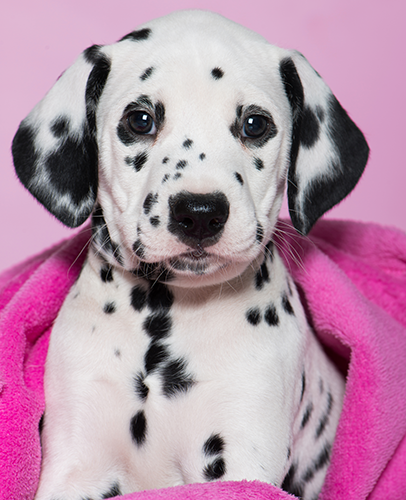 This article on Dalmatians is part of a series to highlight the Big Picture of health, welfare and breeding and to help develop Globally Relevant Integrated Health Profiles (GRIHPs) for many breeds. See IPFD's Get a GRIHP! on Breed Health Initiative.
This article on Dalmatians is part of a series to highlight the Big Picture of health, welfare and breeding and to help develop Globally Relevant Integrated Health Profiles (GRIHPs) for many breeds. See IPFD's Get a GRIHP! on Breed Health Initiative.
 Donate
Donate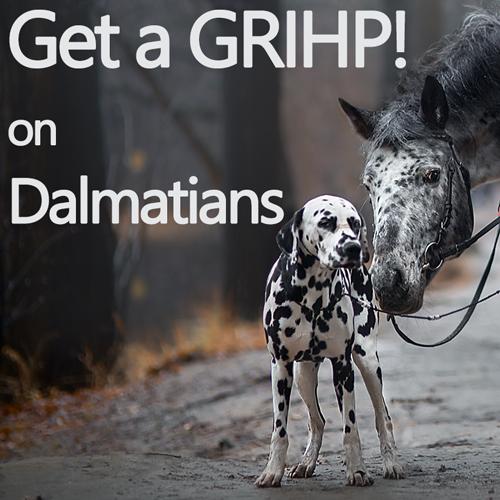

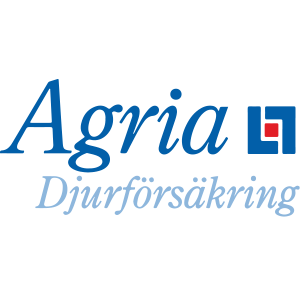 Agria - Swedish Breed Profiles
Agria - Swedish Breed Profiles
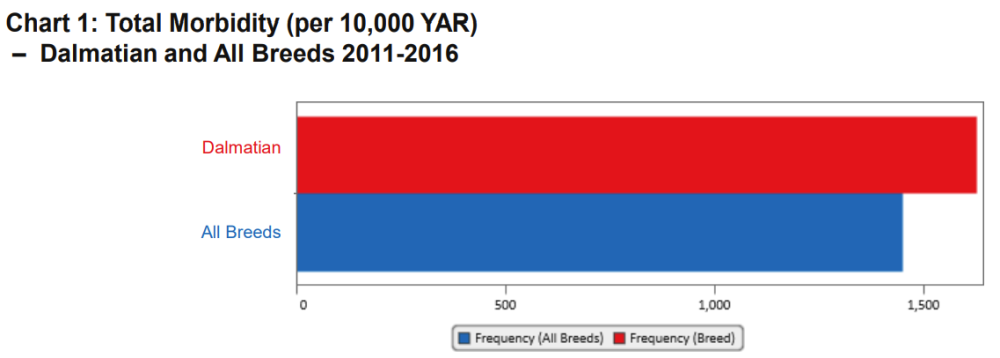
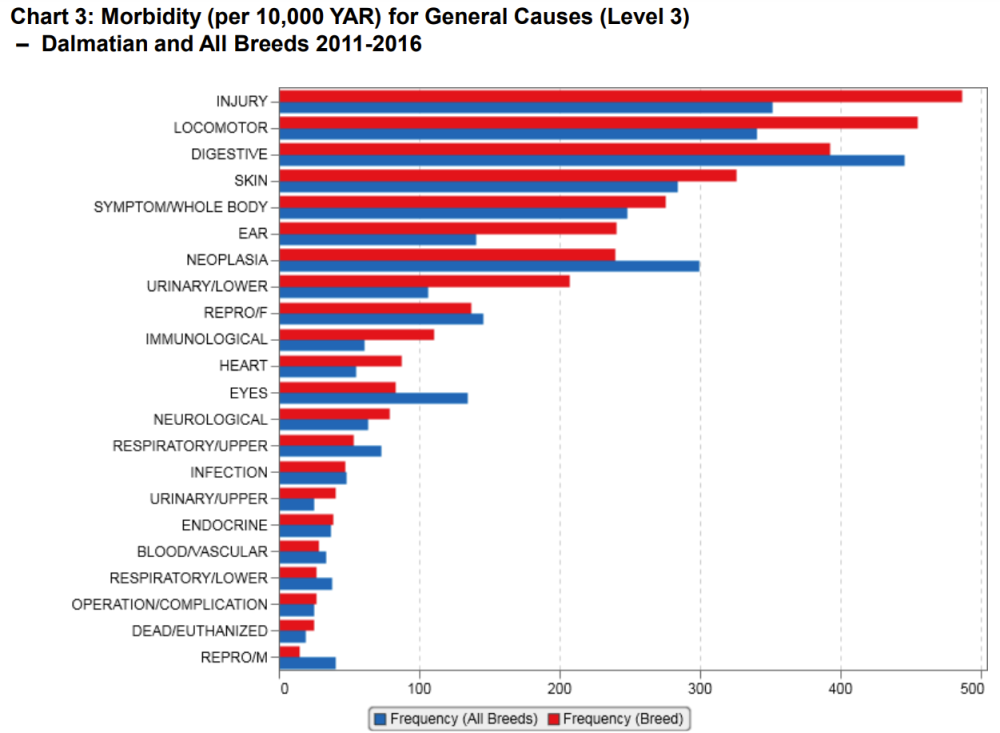

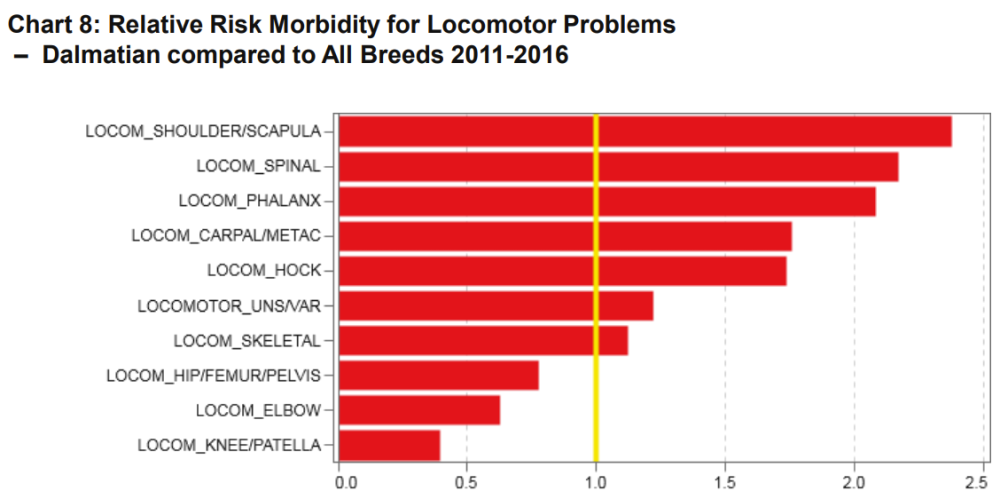

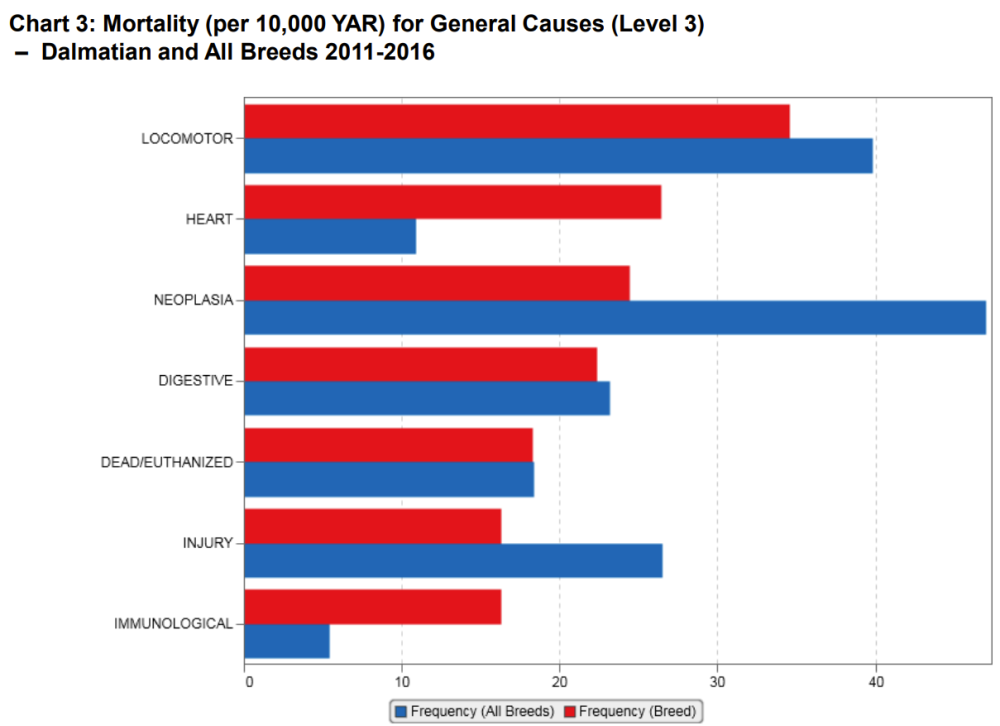
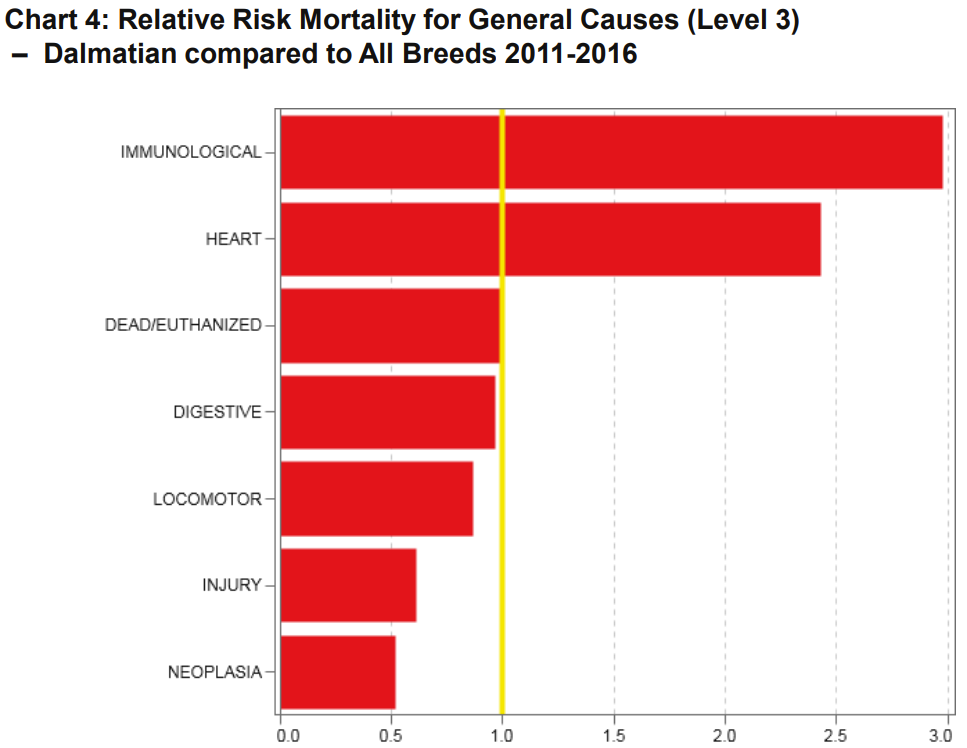
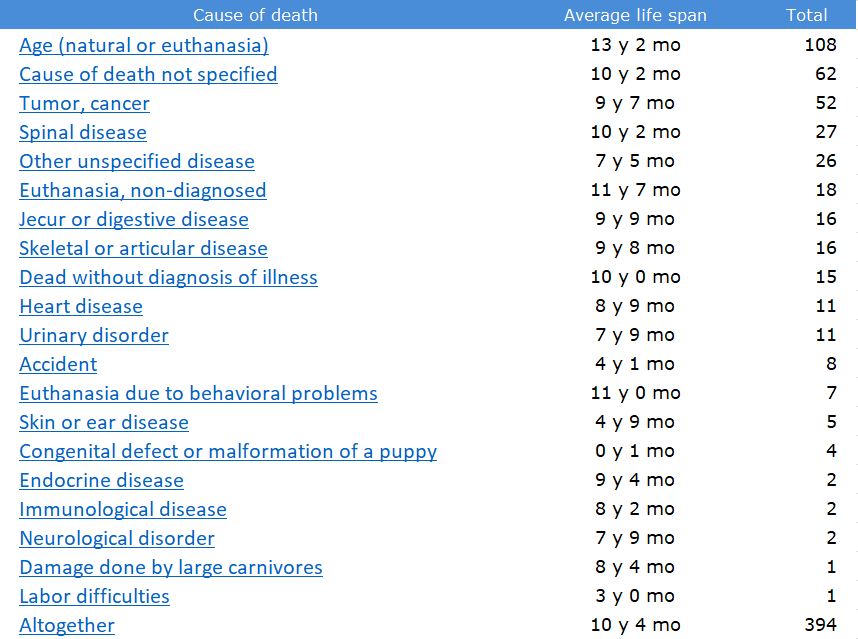
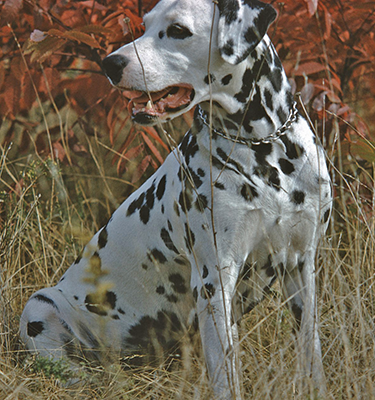 ency rate for the mutation (under 2%), meaning this condition may be rare or uncommon in the breed. This also means that effective elimination of the ARDS in the breed could happen with sensible breeding practices to avoid producing puppies with this genetic variation. In the research study, Pointers were also tested for the mutation, but in the samples available, it was not detected. However, ARDS is described in many species and across many types of dogs, so it is possible that other breeds have unique as yet unknown genetic risks. Tests for this specific variant should be assumed to be informative for Dalmatians (and Dalmatian crosses) only, for the time being.
ency rate for the mutation (under 2%), meaning this condition may be rare or uncommon in the breed. This also means that effective elimination of the ARDS in the breed could happen with sensible breeding practices to avoid producing puppies with this genetic variation. In the research study, Pointers were also tested for the mutation, but in the samples available, it was not detected. However, ARDS is described in many species and across many types of dogs, so it is possible that other breeds have unique as yet unknown genetic risks. Tests for this specific variant should be assumed to be informative for Dalmatians (and Dalmatian crosses) only, for the time being.
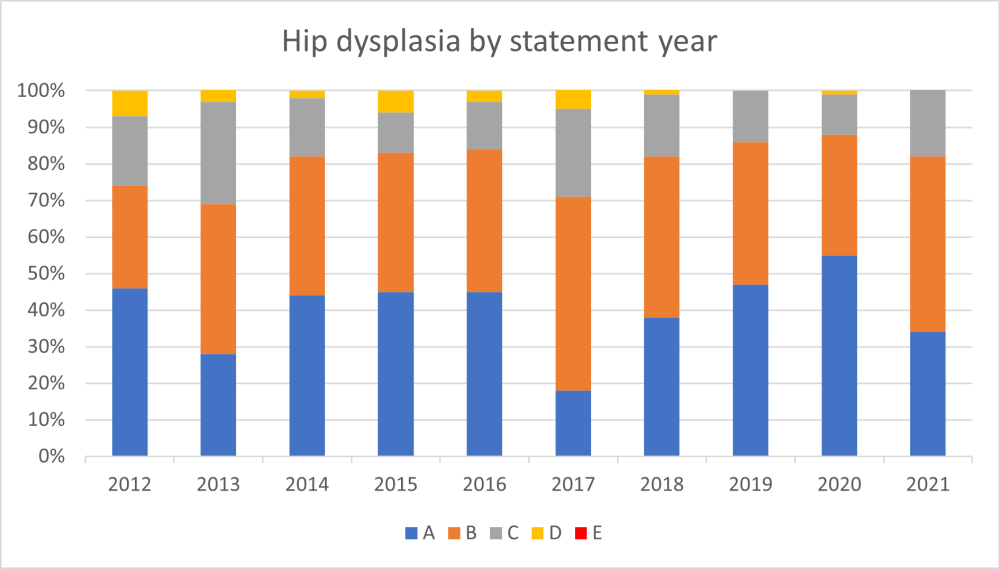

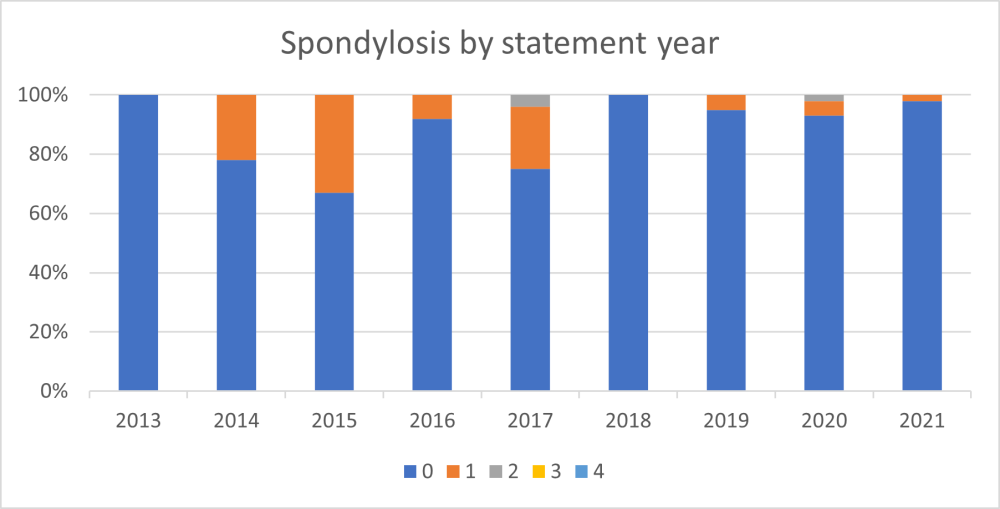
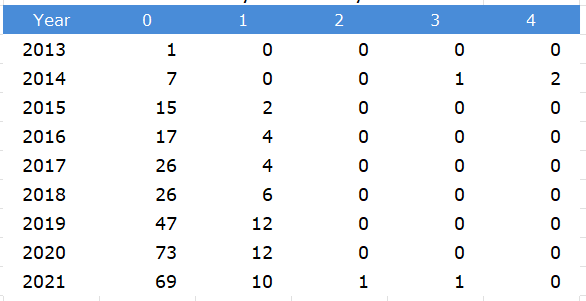

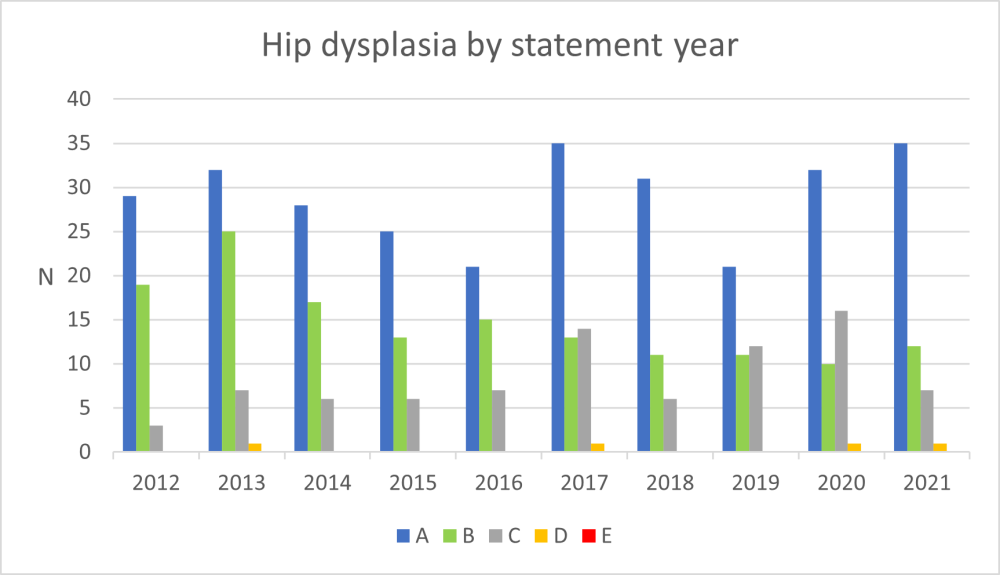
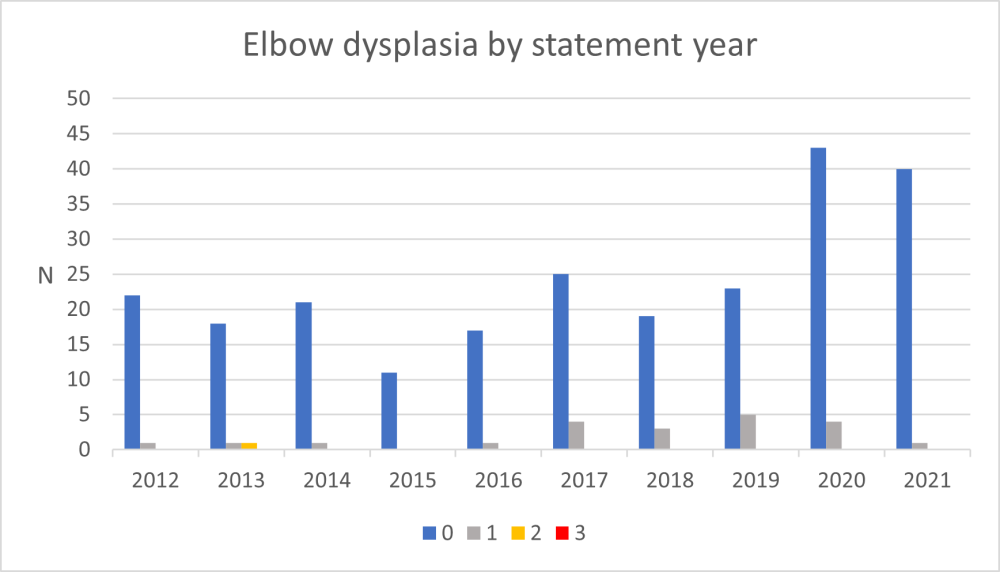



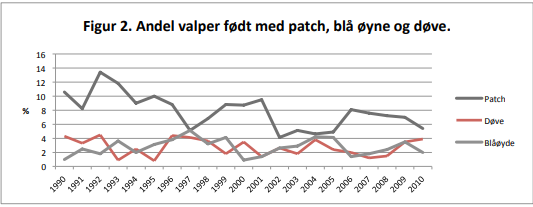

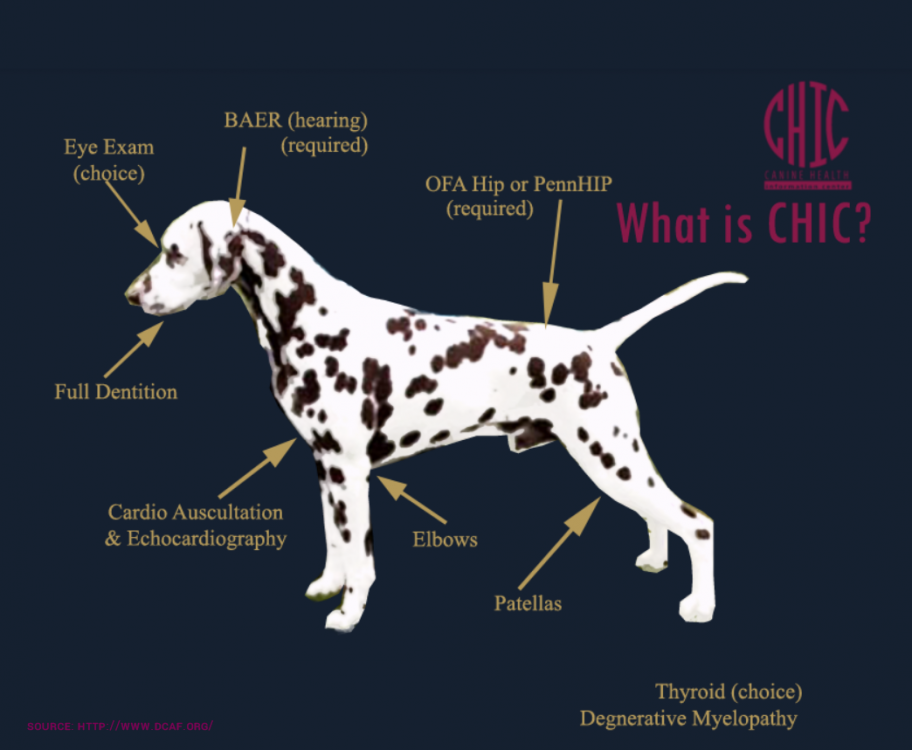
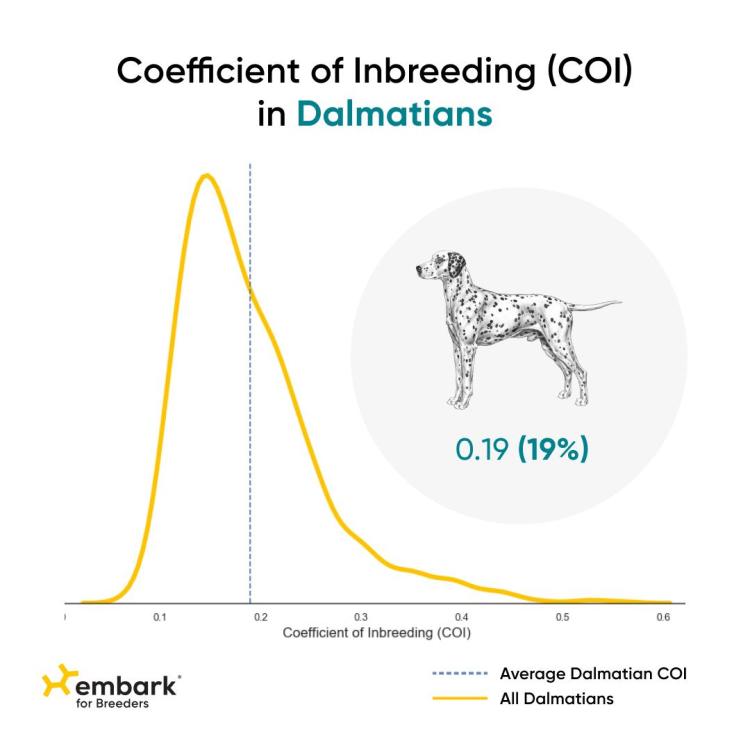


Recommended Comments
There are no comments to display.
Join the conversation
You can post now and register later. If you have an account, sign in now to post with your account.
Note: Your post will require moderator approval before it will be visible.